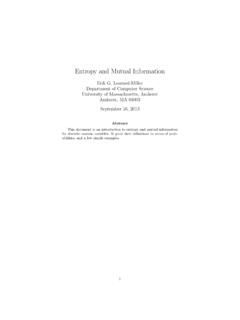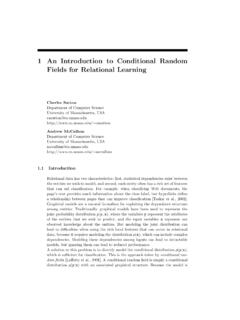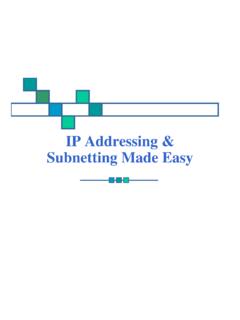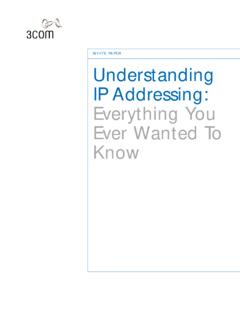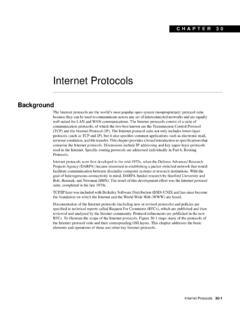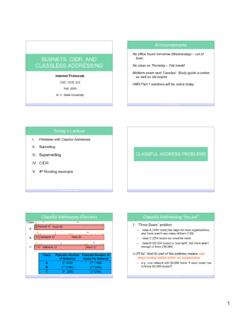Transcription of IP Addressing - UMass Amherst
1 IP Addressing Introductory material. A module devoted to IP addresses. Addresses & Names Hardware (Layer 2) Lowest level Ethernet (MAC), Serial point-to-point, .. Network (Layer 3) IP IPX, SNA, others Transport (Layer 4) port numbers in TCP/IP Application (Layer 5) Names (URL), alias, .. Why do we need IP addresses? Q: Why have both an IP and MAC address for each interface? Why not simply make do with MAC addresses? A: Scalable routing. Let s walk through a simple host-to-host packet delivery example and then understand how the structure of IP addresses helps scale routing.
2 Host-to-Host Packet Delivery (1 of 10) 4 IP Addressing Host-to-Host Packet Delivery (2 of 10) 5 IP Addressing Host-to-Host Packet Delivery (3 of 10) 6 IP Addressing Host-to-Host Packet Delivery (4 of 10) 7 IP Addressing Host-to-Host Packet Delivery (5 of 10) 8 IP Addressing Host-to-Host Packet Delivery (6 of 10) 9 IP Addressing Host-to-Host Packet Delivery (7 of 10) 10 IP Addressing Host-to-Host Packet Delivery (8 of 10) 11 IP Addressing Host-to-Host Packet Delivery (9 of 10) 12 IP Addressing Host-to-Host Packet Delivery (10 of 10) 13 IP Addressing Why IP addresses?
3 A MAC address has no structure, so it tells a switch the identity (who) of the destination interface but not its location (where). With just MAC addresses, switches would have to resort to broadcast the first time they encounter a new address. Switch forwarding table sizes would be on the order of the total number of MAC addresses. IP Addresses Structure of an IP address subnetting CIDR prefixes vs. old classful IP addresses IP Version 6 addresses IP Addresses Application dataTCP HeaderEthernet HeaderEthernet TrailerEthernet frameIP Headerversion(4 bits)headerlengthType of Service/TOS(8 bits)Total Length (in bytes)(16 bits)Identification (16 bits)flags(3 bits)Fragment Offset (13 bits)Source IP address (32 bits)Destination IP address (32 bits)TTL Time-to-Live(8 bits)Protocol(8 bits)Header Checksum (16 bits) 32 bitsWhat is an IP Address?
4 An IP address is a unique global address for a network interface Exceptions: Dynamically assigned IP addresses ( DHCP, Lab 7) IP addresses in private networks ( NAT, Lab 7) An IP address: - is a 32 bit long identifier - encodes a network number (network prefix) and a host number The network prefix identifies a network and the host number identifies a specific host (actually, interface on the network). How do we know how long the network prefix is? Before 1993: The network prefix is implicitly defined (see class-based Addressing ) or After 1993: The network prefix is indicated by a netmask.
5 Network prefix and host number network prefix host number Dotted Decimal Notation IP addresses are written in a so-called dotted decimal notation Each byte is identified by a decimal number in the range [ ]: Example: 10001111 10000000 10001001 10010000 1st Byte = 128 2nd Byte = 143 3rd Byte = 137 4th Byte = 144 Example: Network address is: (or ) Host number is: Netmask is: (or ffff0000) Prefix or CIDR notation: Network prefix is 16 bits long Example Special IP Addresses Reserved or (by convention) special addresses.
6 Loopback interfaces all addresses are reserved for loopback interfaces Most systems use as loopback address loopback interface is associated with name localhost IP address of a network Host number is set to all zeros, , Broadcast address Host number is all ones, , Broadcast goes to all hosts on the network Often ignored due to security concerns Test / Experimental addresses Certain address ranges are reserved for experimental use . Packets should get dropped if they contain this destination address (see RFC 1918): - - - Convention (but not a reserved address) Default gateway has host number set to 1 , , , subnetting subnetting Problem: Organizations have multiple networks which are independently managed Solution 1: Allocate a separate network address for each network Difficult to manage From the outside of the organization, each network must be addressable.
7 Solution 2: Add another level of hierarchy to the IP Addressing structure University Network Medical School Library Engineering School Each part of the organization is allocated a range of IP addresses (subnets or subnetworks) Addresses in each subnet can be administered locally Address assignment with subnetting University Network Medical School Library Engineering School Basic Idea of subnetting Split the host number portion of an IP address into a subnet number and a (smaller)
8 Host number. Result is a 3-layer hierarchy Then: Subnets can be freely assigned within the organization Internally, subnets are treated as separate networks Subnet structure is not visible outside the organization network prefix host number subnet number network prefix host number extended network prefix Routers and hosts use an extended network prefix (subnetmask) to identify the start of the host numbers Subnetmask prefixhost prefixhost numbersubnetnumber137extended network prefix11111111111111111111111100000000su bnetmaskAdvantages of subnetting With subnetting , IP addresses use a 3-layer hierarchy: Network Subnet Host Reduces router complexity.
9 Since external routers do not know about subnetting , the complexity of routing tables at external routers is reduced. Note: Length of the subnet mask need not be identical at all subnetworks. Example: Subnetmask is the IP address of the network is the IP address of the subnet is the IP address of the host (or ffffff00) is the subnetmask of the host When subnetting is used, one generally speaks of a subnetmask (instead of a netmask) and a subnet (instead of a network) Use of subnetting or length of the subnetmask if decided by the network administrator Consistency of subnetmasks is responsibility of administrator No subnetting All hosts think that the other hosts are on the same network : : : : : : : : subnetting Hosts with same extended network prefix belong to the same network Different subnetmasks lead to different views of the size of the scope of the network.
10 subnetting Classful IP Adresses (Until 1993) When Internet addresses were standardized (early 1980s), the Internet address space was divided up into classes: Class A: Network prefix is 8 bits long Class B: Network prefix is 16 bits long Class C: Network prefix is 24 bits long Each IP address contained a key which identifies the class: Class A: IP address starts with 0 Class B: IP address starts with 10 Class C: IP address starts with 110 The old way: Internet Address Classes Class Cnetwork idhost110 Network Prefix24 bitsHost Number8 bitsbit #0123242313 Class B1network idhostbit #0115162 Network Prefix16 bitsHost Number16 bits031 Class A0 Network Prefix8 bitsbit #0178 Host Number24 bits31 Class Dmulticast group id111bit #01231304 Class E(reserved for future use)111bit #0123131405 The old way: Internet Address Classes We will learn about multicast addresses later in this course.




